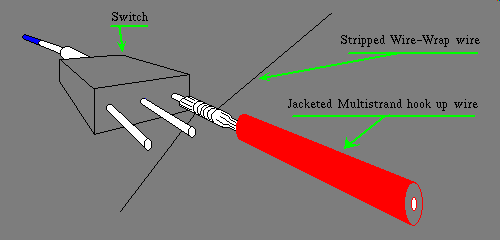They make a series of interconnection products, for a class of one time prototype assembly work, generically called "Wire Wrap" These products include Integrated Circuit Sockets, that have lead lengths from 0.4 inches to 0.7 inch. Upon close inspection these pins have sharp square corners. They are made this way because the square edges bite into the bare conductor that is twisted on by hand with the aid of a device called a "Wire Wrap Tool" The degree to which they bite into the conductor is surprising, the force is so extreme it forms what is known as a "pressure weld" literally metal welded together by shear force of compression. It forms a "gas tight" seal, that prevents metal oxides from forming, and thus causing a failure. The sharp cornered pins themselves are usually gold plated, and the Wire Wrap Wire itself is usually silver plated. These plating metals are chosen for their chemical stability, that is resistance to reacting to oxygen in the surrounding air, and for their malleability, in other words they are soft, as metals go, and in the presents of the tiny anvil, inside the "Wire Wrap Tool" they are squeezed so tightly together that the aforementioned "pressure weld" is formed. Ok so much for "Wire Wrap" my purpose is not to have you build a wire wrap prototype rather, I am going to have you abuse yet another set of tools, to produce what is likely the finest soldering job in the industry. Once again Radio Shack to the rescue, mind you, I'm not championing Radio Shack, it's just that they are so wide spread, and they sell 30 gauge Wire Wrap Wire stock number 278-501 or 278-502 or 278-503 depending on color, and they also sell what is arguably the best Wire Wrap Tool in the industry stock number 276-1570 it costs almost eight dollars, and you'll wonder how something that looks like a simple Jewelers Screwdriver could cost that much, but trust me, I've used lots of them, and none of them, even the battery powered ones, that cost fifty bucks do as nice a job. Anyway, as I said, this is not about Wire Wrap, it's about using wire wrap wire to perform real professional soldering of off board lead wires to terminals in really tight places. The solder you use is also an important factor. Solder is an alloy of tin, and lead. Good solder is shaped like a pipe, or a hose, and is pre-filled with Rosin Flux, a chemical that keeps impurities out of the joint that is being soldered. The best solders have Multiple cores, that is holes that hold the Flux, and they are 63% Tin, and 37% Lead, and are often designated SN63, which is sometimes referred to as the Eutectic Alloy of solder. The thing that makes SN63 special, is that it possesses the lowest melting point, this means you are more likely to melt the solder, and get the joint soldered, without damaging the device, or burning up the wires insulation.
In the following drawing I show some preparation using stripped Wire Wrap Wire to temporarily hold the Multistrand wire in place while the soldering takes place. Notice that the wire wrap wire is either stretched tight, or at least tightly wound while the terminal is soldered. The wire wrap wire regrettably becomes part of the solder joint, when the job is finished.

After Soldering the joint, and all the others nearby, snip off any excess wire wrap wire, or stray threads of the multistrand cable, and slide on some Heat Shrink Tubing, and heat it carefully with a butane lighter, carefully meaning don't over do it. The stuff will melt if you heat it too much.